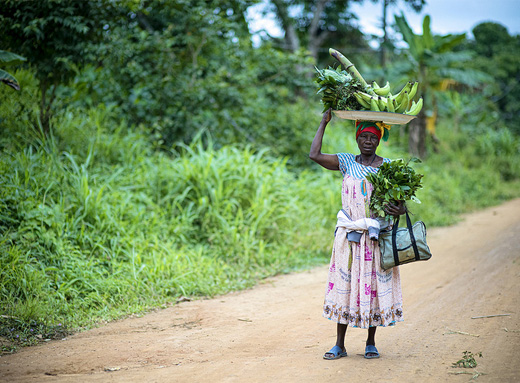
Forests have long been a crucial source of nutritious food for people in Central Africa. Ollivier Girard/CIFOR
YAOUNDE, Cameroon (24 May, 2013)_Ever more of Central Africa’s forests are being felled to clear space for high-calorie, low-nutrient staple and cash crops such as maize or cassava. But it seems that food and nutrition security in Central Africa may be getting back to its roots: forests.
Forests have long been a crucial source of nutritious food for people in Central Africa, but urbanization, agricultural pressures, and the integration of the region into the global market economy have led many away from the lifestyles of decades past.
Essimi Menye, the Cameroonian Minister of Agriculture and Rural Development, however, tells of a time when the forests of Cameroon were a lifeline for his family.
Every May, the family’s crops would be flowering, but there was nothing to harvest yet and little to eat. So the nearby forests became a fallback.
“This is where we found food – fruits, meats…we lived on the hunting of small animals – even insects,” he said at the two-day policy conference Forest Management in Central Africa: Yesterday, Today and Tomorrow.
“But today, we don’t know those periods of want anymore,” Menye added.
“Now we have wheat.”
As it has in many developing countries, a focus on increasing production of high-calorie crops such as wheat or rice has often come at the expense of forests. On top of that, achieving food and nutrition security will require more than just greater staple crop production.
Recently, researchers with the Center for International Forestry Research (CIFOR) and elsewhere have begun to take a more holistic look at the role forests play, as part of the broader landscape, in providing nutritious food to rural people.
Eat your vegetables
Nutrient deficiencies plague Africa, causing “hidden hunger” even when there is enough food to eat. Nearly 30 percent of people in Africa have Vitamin A deficiency, according to the UN Food and Agriculture Organization (FAO). The incidence of anemia among children on the continent is shockingly high, at 68%. What is needed, said CIFOR scientist Bronwen Powell, is better dietary diversity.
“Experts from the nutrition community promote dietary diversity because it is holistic. Eating a varied diet can help to help ensure adequate intake of multiple essential nutrients, rather than strategies that focus on one nutrient at a time,” she said.
The numbers bear this out: Africa has one of the world’s lowest rates of consumption of fruits and vegetables, Powell said, citing research from the International Food Policy Research Institute (IFPRI).
While agriculture is important for providing staple crops, forests and wild foods provide additional diversity of foods. Fruits, meats, legumes and leafy greens –foods packed with micronutrients – can be found in abundance in healthy, well-managed forests.
But even a “tamed” forest is a beneficial option. Zacharie Tchoundjeu, a forester with the World Agroforestry Centre, has been working on domestication of fruit trees in Central Africa since the 1990s, with the aim of boosting nutrition as well as economic development.
The rural people in Cameroon he was seeking to aid were resistant at first, but when asked what they wanted from research, “they gave us a road map,” Tchoundjeu said.
“They wanted trees that produce lots of fruit, and quickly – and not too tall so that children don’t get injured from falling out while collecting fruit.”
Tchoundjeu’s team went to work, and now these domesticated trees – many of them mango trees – don’t just provide nourishment, they also provide a source of cash for rural people who sell their extra fruit.
But solving Central Africa’s food and nutrition security problems isn’t as simple as introducing new crop varieties and planting more trees, experts said.
Careful planning and policy research is required, Powell said: “It’s essential to consider at a policy level how forest issues will affect changes in diet, particularly fruit and vegetable consumption.”
For researchers in the Congo Basin, though, it is becoming clear that forests play a larger role in nourishing rural people than was previously thought — presenting an opportunity to rethink food security at a time when malnutrition persists despite the fact that many people have enough to eat.
“When you eat until you’re full, you have food security,” Tchoundjeu said, “but nutritional security is something else.”
We want you to share Forests News content, which is licensed under Creative Commons Attribution-NonCommercial-ShareAlike 4.0 International (CC BY-NC-SA 4.0). This means you are free to redistribute our material for non-commercial purposes. All we ask is that you give Forests News appropriate credit and link to the original Forests News content, indicate if changes were made, and distribute your contributions under the same Creative Commons license. You must notify Forests News if you repost, reprint or reuse our materials by contacting forestsnews@cifor-icraf.org.